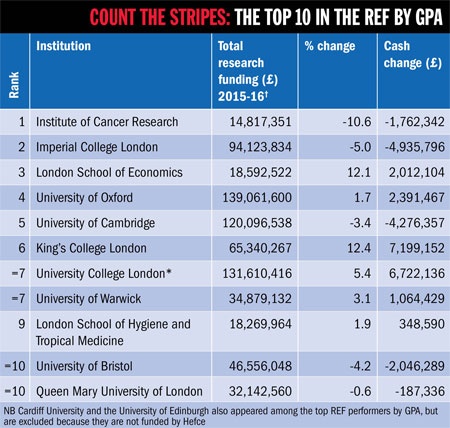Download the Total Funding for English Higher Education Institutions 2015-16 tables
The University of Manchester is the biggest loser in the first set of English funding allocations to be based on the results of the 2014 research excellence framework, while King’s College London is set to gain most.
The 2015-16 research grants for English universities are also the first to be based on the Higher Education Funding Council for England’s revised formula for distributing quality-related funding, which gives four times (instead of three times) as much funding to research rated 4* (world leading) as to that rated 3* (internationally excellent).
Published on 26 March, the allocations show that Manchester’s share of the £1.6 billion research funding pot will fall by 12.7 per cent in 2015-16 compared with 2014-15, amounting to a loss of £10.6 million. The fall would have been 17.1 per cent (£14.2 million – see tables) were it not for Manchester’s healthy share of a £52 million “transitional allocation” from Hefce on top of the standard research budget.
That sum includes £24 million for postgraduate support and £28 million to ensure that “no institution experiences a reduction in funding directly because of” Hefce’s removal of the ring-fence around funding for science, technology, engineering and mathematics. This funding is not expected to be available beyond 2015-16, although Hefce notes that its assumption of a flat-cash settlement in the post-election spending review is very uncertain and it reserves the right to revisit allocations.
Imperial College London receives by far the most transitional funding – £10.9 million – boosting its overall income by 6 per cent. However, that will become a 5 per cent drop in 2016-17 unless the funding formula is revisited. The University of Cambridge is also set for a 3.4 per cent loss.
Manchester’s huge cash loss is a result of a disappointing REF performance, in which it slid from eighth in the 2008 research assessment exercise to 17th by grade point average despite submitting 263 fewer staff.
But it does not suffer the largest proportional loss in income: London Metropolitan University and the University of the Arts London will both lose more than 45 per cent of their funding post-transition (see tables). The universities of Bradford, Sunderland and Salford will also lose more than 30 per cent.
By contrast, King’s College London wins the most extra cash post-transition: £7.2 million. The institution rose from joint 22nd in the 2008 RAE to seventh in the REF by GPA, and submitted 197 more people.
University College London gains the most funding – £11 million –when transitional funding is included, and the second most post-transition. It is now the second-most highly funded institution for research income, having submitted 773 more staff to the REF after several mergers. The University of Oxford remains the most highly funded institution, gaining £2.4 million (1.7 per cent) post-transition (see table, above).
Some post-92 universities are also among the biggest cash winners. Even post-transition, Northumbria University will be £3.3 million up after more than doubling the size of its submission and the University of Huddersfield will gain £2.8 million. But the largest proportional gains among those with at least £1 million in funding will be at the University of Bedfordshire and Edge Hill University. Both more than doubled the size of their REF submissions.

Manchester is not the only northern university to suffer. Members of the N8 group of research intensives will lose 8 per cent of their funding post-transition, with all but one (Lancaster University) taking hits. This is largely because all submitted fewer staff to the REF.
Of the 21 institutions that submitted 80 per cent or more of eligible staff, 12 will gain funding post-transition. But big grant losses are set to hit Goldsmiths, University of London (29.5 per cent) and Loughborough University (14.1 per cent).
Those in the top 10 of the REF by GPA (see table, above) vary markedly, with only six seeing increases post-transition. The top institution, the Institute of Cancer Research, will be 10.6 per cent poorer.
Funding concentration has been slightly relaxed, with the share going to the largest 10 institutions falling from 52.4 to 51.6 per cent post-transition and the share going to the Russell Group (see pie chart) falling from 71.9 to 70.8 per cent.
The amount of research funding distributed by Hefce now exceeds the amount of teaching funding because almost all students are now under the £9,000 tuition fees regime. However, meaningful comparisons of teaching funding allocations with previous years remain difficult.
Hefce warns that uncertainty about post-election politics means that teaching funding could also change in-year, but £37 million has been earmarked to support increases in student numbers in 2015-16, to be distributed next February.
Register to continue
Why register?
- Registration is free and only takes a moment
- Once registered, you can read 3 articles a month
- Sign up for our newsletter
Subscribe
Or subscribe for unlimited access to:
- Unlimited access to news, views, insights & reviews
- Digital editions
- Digital access to THE’s university and college rankings analysis
Already registered or a current subscriber?





